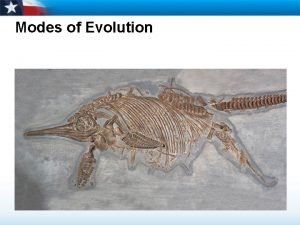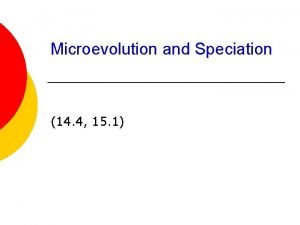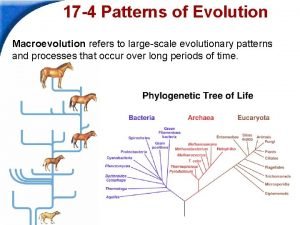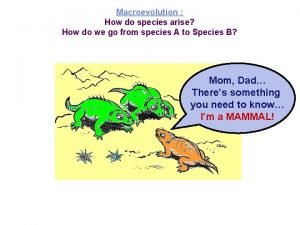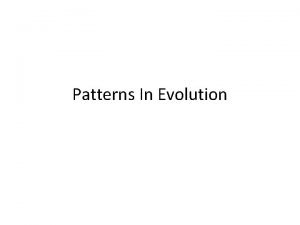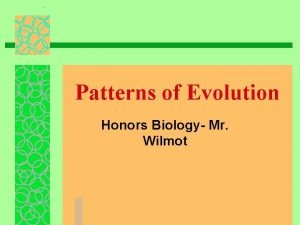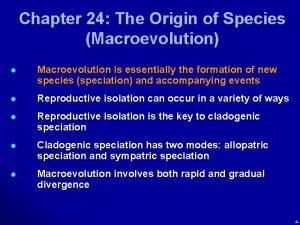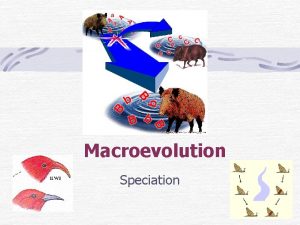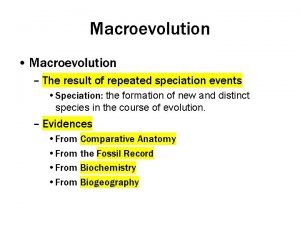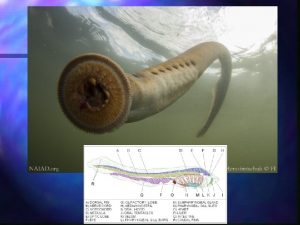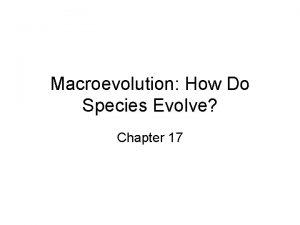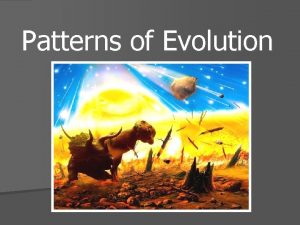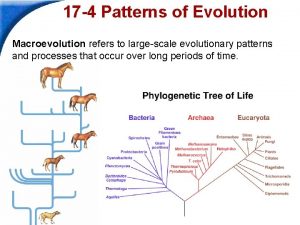MACROEVOLUTION Macroevolution refers to the concept of largescale









- Slides: 9

MACROEVOLUTION Macroevolution refers to the concept of largescale evolution that occurs at the level of species and above. Macroevolution can be used to describe the differences between two closely related but distinct species, such as the Asian Elephant and the African Elephant, which cannot mate due to the barriers imposed by reproductive isolation. This is the process of speciation, which can be driven by a number of different mechanisms

• The term macroevolution can also be used to explain the shared common ancestry between all living organisms, a concept known as Universal Common Descent. This describes the derivation of all existent and extinct life forms from a single origin, and includes evolutionary milestones such as the origins of plants, mammals, reptiles, birds, fish, nonavian dinosaurs and more.

• Among the evolutionary mechanisms— mutation, gene flow, genetic drift and natural selection—alter the gene pool of a population through microevolution, will accumulate over a long time period, resulting ultimately in macroevolution. In the case of Universal Common Decent, microevolution has been driving the macroevolution of living organisms for 3. 8 billion years (that’s 3, 800, 000 years

• Examples of Macroevolution • 1. The Evolution of Sirenians • The sirenians are a group of mammals within the placental mammals, consisting of the manatees and the Dugong, as well as other extinct species. • Also known as the ‘sea cows’, the sirenians feed solely on sea grass and are the only herbivorous aquatic mammals. They share a common ancestor with the elephants and the extinct mammoths, in a taxonomic group called the Tethytheria. The evidence for the macroevolution that has separated these groups of animals comes from vestigial structures within their bodies. • Firstly, the flippers of sirenians have internal bone structures that are homologous to the bone structure of all other terrestrial tetrapods (four legged animals). Each flipper contains an upper arm bone; two forearm bones, wrist bones, hand bones and five finger bones. On the external tips of their flippers the sirenians have toenails, which are the same as those seen in elephants.

• the evidence that the sirenians share a common ancestor with other Tethytheria, and have evolved through macroevolution, a 50 million year old fossilized skeleton of a sirenian was found in Jamaica. The fossil had the features of a modern sirenian— including a solid boned skeleton to weigh it down in the water and nostrils on the back its head allowing it to breath at the surface—but it also had four welldeveloped legs! Several other similar fossil skeletons have also been found with the hind legs, although reduced in size; so reduced that they would not have been able to support the weight of the animal. •

• From the modern physical evidence of the vestigial structures, as well as the fossil evidence, it is clear that the sirenians share a common ancestor with modern elephants. Originally landdwelling animals, the ancestors of the sirenians would have utilized the food source of sea grass within marine environments. As the hind limbs are not much use in the water, these became gradually smaller over millions of years until disappearing completely, leaving only some boney reminders of their land-based ancestors.

• 2. Example of macroevolution. It is possible to view the evidence for macroevolution through the similarities and differences between the genetic information stored within all living organisms. The genetic information, which determines the characteristics that will be displayed in any organism, is held within strands of nucleotide basescalled DNA. The sequence of the nucleotides within the DNA is used as a code, giving precise instructions for the production of amino acids; amino acids are the ‘building blocks’ of proteins, which in turn build living cells.

• A strong piece of evidence for theory of Universal Common Descent comes from the fact that every living organism—except some prokaryotes that contain only RNA, which split from other lineages very early in evolutionary history—use DNA consisting of the same nucleotides, arranged in the same manner, to code for the production of amino acids. Furthermore, the proteins of all organisms are comprised of combinations of exactly the same 20 amino acids, without exception.

• Over time and during reproduction, the genetic information is replicated and slight mutations in the sequences of nucleotides occur, resulting in slightly altered DNA strands and thus altered sequences of amino acids and proteins. • This is well demonstrable with the sequence of amino acids present in a protein that is present in nearly all animals, hemoglobin. Used to transport oxygen around the body, hemoglobin is made up of two sets of identical amino acid chains: one pair consisting of 141 amino acids and the other consisting of 146.
